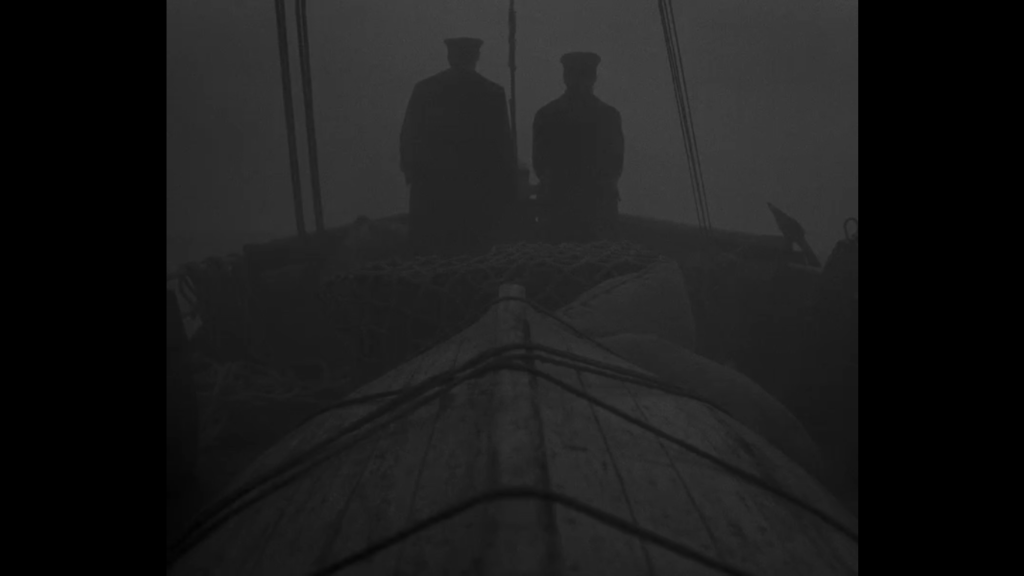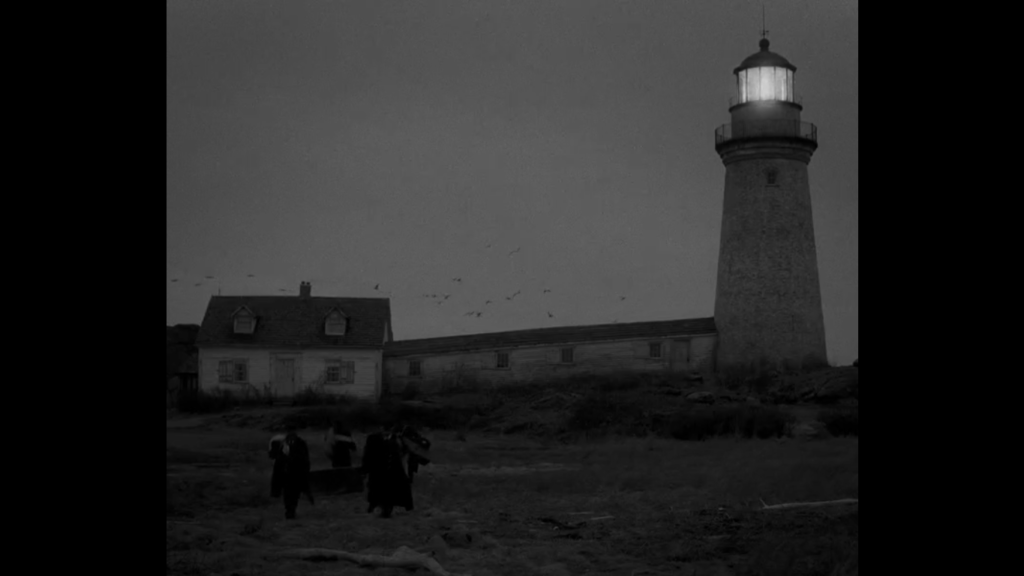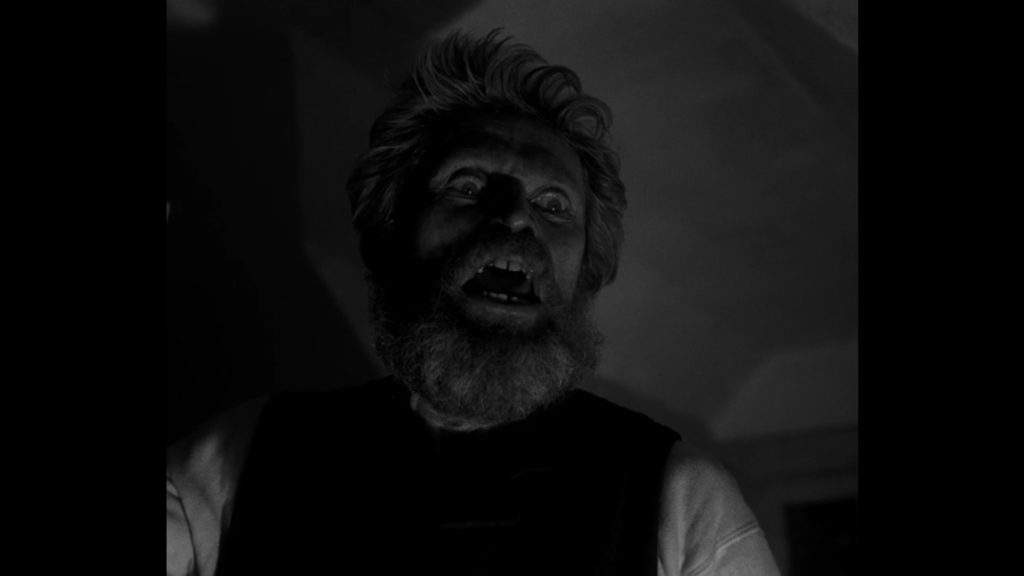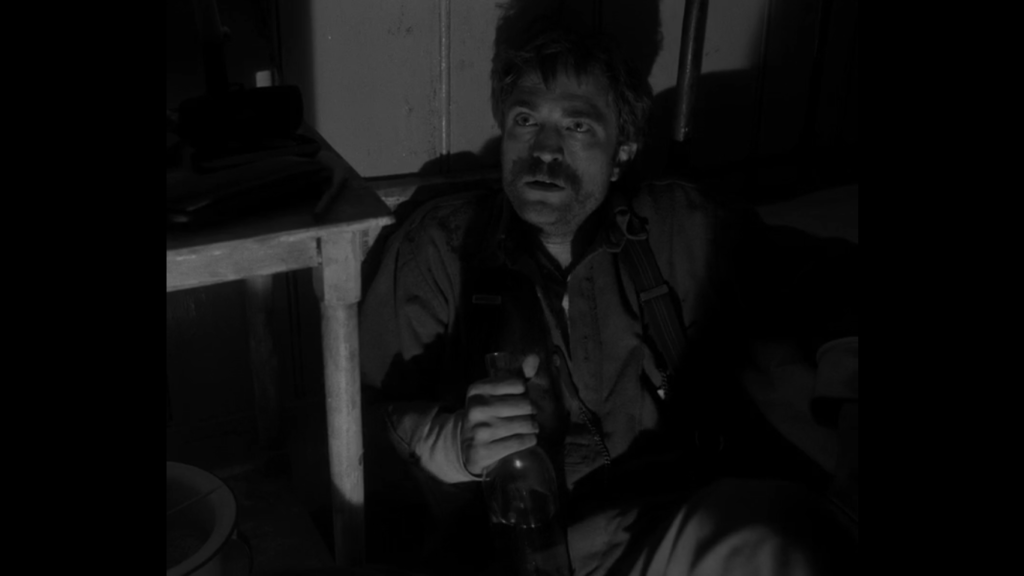Note: In August, your friend and humble narrator, Streebo, was asked to join the A24 vs Blumhouse discussion over at Mad Monster.com.
Awooga.
Your first interaction with Robert Eggers’ The Lighthouse comes in the form of the ever-present fog-horn. It sets a neverending tempo, like a heart soggy with saltwater, intermittently beating its way through the film.
The Lighthouse tells the story of two lighthouse keepers (and one tenacious gull) on an unnamed New England island in the late nineteenth century. What starts as a dark character study quickly devolves into a descent into madness and more.

The first visual breaks the darkness with a grey mass of water. A ship breaks the horizon and figures in stark black and white contrast stand monolithic at the stern. These two lone passengers brave the water and wind to make the journey to the eponymous lighthouse on a remote island.
As these subjects come into focus, we are struck by the choice of aspect ratio for this film, as it is filmed in full-frame or 1:19.1 ratio as used in the 1920s. The choice of storytelling period is not one of chance, as H.P.Lovecraft and his contemporaries first plied their trade at this time churning out stories of madness and cosmic terror in the pages of Astounding Stories and Weird Tales magazines.
This framing device along with the choice of stark black and white photography brought to mind the film noir theory of Liminalism and the use of framing subjects in the visual frame of the lens so to speak. In most film noir this might be done by having a figure in a doorway, outlined by rigid wood, but here the subject is boxed in by the ever-present blackness of the boundaries of the frame in which it will exist.
Pattinson’s younger keeper is inducted by the old keeper, played by Willem Dafoe, and introduced to a way of life that promises little outside of hardship and the possibility of being stranded on an island at sea. They share tales of school, sing songs of the sea, and wash it all down with the salty grog of an idiom that comes from living in cramped quarters turned brown by the sweat and salt of greasy men.

We are treated to character pieces that call to mind the greatest moments of Quint and Hooper trading shark tales in JAWS. We see moments of pure emotion, despair, and ferocity with both Robert Pattinson and Willem Dafoe turning in career-best performances. For Pattinson, this is meant as a compliment, as I am a fan of his earlier work in Cronenberg’s Cosmopolitan. For Dafoe, this is praise well-deserved for a man with an already legendary resume.
As much as this film is grounded in the gritty veracity of blue-collar work down in the rain and muck, The Lighthouse also reveals the otherworldly and the fantastique hiding amid its shadows. Jungian symbols of water, the subconscious, and even the anima are all represented on this lonely island.
Narrative choices help the viewer become immersed into the world of the lighthouse keeper. Pattinson’s young keeper isn’t given any sort of a proper name for almost half an hour into the film, and Defoe’s older keeper is named even later still.
They work, while we watch. There will be a time for names later.

Awooga.
With this work, comes isolation, frustration, and madness. Above it all shines the beacon of hope, truth, and love, yes, even love, the Lighthouse. Pattinson’s younger man is kept ruthlessly busy with work and haunted by visions at night and tales of temptations at sea during the day. While Pattinson struggles with his inner demons, Dafoe’s keeper is alone worthy of tending the lighthouse directly.
He carries the key to the door and much like Blackbeard, or perhaps Uriel the angel at the gates of Eden, forbids Pattinson’s apprentice keeper from ever entering. Don’t go in there. It is forbidden. Like the Holy Grail before it, the Lighthouse reveals the truth and only the purest of heart may approach it unscathed.
Pattinson and Defoe take turns leading their macabre dance to what seems an inevitable ending. Dafoe’s wretched old keeper looms over the proceedings like a withered Sea God. He passes judgment overall he sees. At one point, he launches into a soliloquy that becomes both terrifying and captivating, “Hark Triton, hark! Bellow bid our father Sea King rise from the depths full foul in his fury!”

The Lighthouse truly offers a mix of powerful storytelling, stark visuals, striking imagery, and mesmerizing music. It is a film that rewards repeat viewings and doesn’t leave so much to the imagination that the viewer is forced to do the work of the screenwriter for them.
Even after it is all said and done, the director Eggers and Max Eggers, his brother and co-writer, leave the final interpretation of events up to you, the viewer. It happened, but what exactly happened?
If you have not seen it, take the time to gaze upon the terrifying beacon of The Lighthouse and dare to learn the truth for yourself.
J.T.McRoberts, aka Streeborama, is a writer for Mutantville Productions. His anthology, Tales from Mutantville, is currently available on DVD from Amazon. Awooga.
Link: https://www.amazon.com/Tales-from-Mutantville/dp/B00CDX0K9I
OVERVIEW
ITEM REVIEWED
Review: The Lighthouse (2019)
AUTHOR
Streeborama
DIRECTOR
Robert Eggers
WRITER
Robert Eggers and Max Eggers
STARRING
Robert Pattinson, Willem Dafoe, and Valeriia Karaman
SYNOPSIS
Two lighthouse keepers battle the elements, their inner demons, and each other as they maintain an isolated lighthouse in the 1890s New England.
RUNTIME
1h 49min
RATING
DIRECTING 5
WRITING 5
CINEMATOGRAPHY 5
ACTING 5
ENTERTAINING 4


